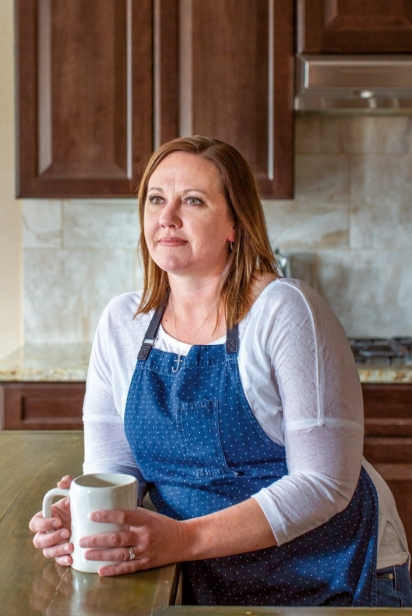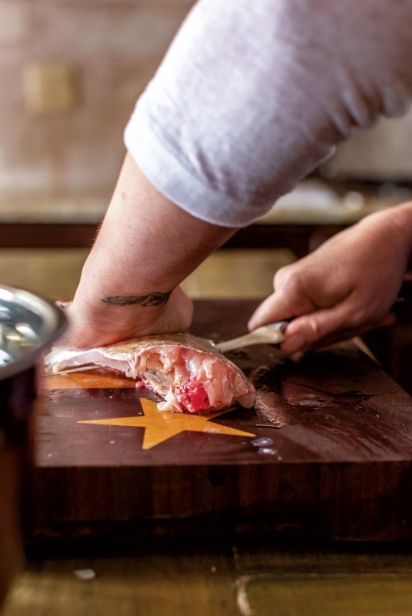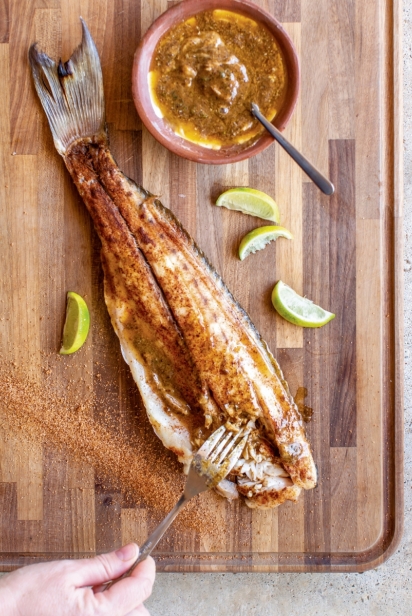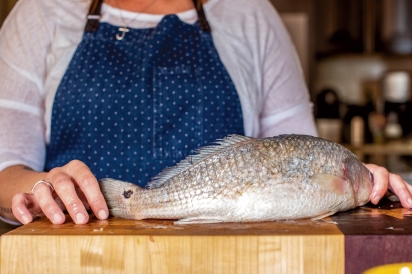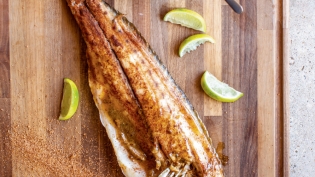In the Kitchen with Houston Chef Jessica DeSham Timmons
My route to Seabrook takes me past NASA Johnson Space Center and along Clear Lake, the brackish lake that empties into Galveston Bay. It is a sunny early February day and the glistening water draws my eyes, reaching to see the bay beyond the lake. “She’s so lucky to be living around here,” I think to myself. ‘She’ is Jessica DeSham Timmons, the chef who co-owns Cherry Block Craft Butcher & Seasonal Kitchen with Felix Florez. She also works with Florez in Black Hill Meats, both of them dedicated “Texans feeding Texans,” a motto that expresses their commitment to responsibly raised meats and collaborations with local farms and ranches. I’m on my way to see her, and cook up some fresh-caught redfish.
But, of course, with a proverbial plate full of to-dos, Timmons’s mind isn’t entirely on the redfish on her kitchen counter. Just the day before, she butchered a whole hog in preparation for the Cochon555 heritage-breed pork competition. Timmons was one of the five chefs. As she scales and rinses her redfish under the tap, dries it and puts it on her cutting board to start filleting, she shares how she planned out her menu:
“When someone hands you a whole hog and says “Make five dishes using the whole animal,” your mind, at first, goes all over the place. Should I go Asian style? Mexican? I’ve always been a huge lover of all things Cajun and Creole. And then it hit me: It’s carnival, so … king cake! A savory king cake filled with liver pâté and braised pork!” With that brainwave, the rest of the menu simply fell into place. A red bean hummus topped with fried tasso. Backbone stew with crisp hominy, almost like a Fritos pie; a tart made with Steen’s cane syrup, miso, cracklings and candied peanuts.
Timmons pushes her flexible boning knife right above the fish’s collar and wiggles it down. She does the same on the other side and the fish head comes away. “It’s very interesting to do this with a just-caught, very, very fresh fish, because they like to flop around a little bit.” She laughs at the surprised expression on my face. “But the fresher the fish, the easier it is to clean.” She turns the fish, and makes a slit in the belly. It is time to gut.
Timmons lives in Seabrook with her husband of 20 years, Johnny, and sons Cooper (18) and Chile (12). They are the fishers in the family—they love to wade in the shallows, patiently waiting for fish to bite. “Mostly, that is speckled trout or redfish,” she says. Both species love the shallow water, and it is easy to take a small boat out, hop out and angle for a good catch. The first house they owned was right on the water on Galveston Bay. “My kids practically grew up fishing. They just walked out the door and into the water. Sometimes, Johnny would wake up Cooper at 10 o’clock at night, and say ‘Come on, let’s go fishing.’”
In season, the guys go duck hunting and, over the years, Timmons developed the same proficiency in cleaning game birds (and even venison) as she has for cleaning fish. Timmons is not an angler or hunter herself, but she does support husband and sons—with a very strict rule: “You eat what you kill,” she says. “I don’t know how many times I told my sons: ‘I’ll cook you that squirrel if you don’t stop shooting your BB gun at it.’”
She scrapes up the fish guts with her knife and discards them in the bowl next to the board. It already contains the fish head. Redfish (aka red drum) has a very tough skin and sharp, thick scales (“those scales can cut you”). Earlier, just after she rinsed and dried the scaled fish, she pointed out the black spots on the fish, one on its tail, and one on its body. “That’s how you recognize redfish. They have at least one large black spot.”
Timmons has a culinary soft spot for authentic, regional Southern cuisine. She is a founding member of Foodways Texas, a grassroots organization dedicated to preserving and promoting Texas food cultures (see sidebar), and serves on its advisory board. Culinary heritage, to her, is part of being a chef.
“One of my favorite recipes for red beans and rice is from my friend’s great-great-great-grandmother. She never wrote it down. No measurements, no directions, just passed down from generation to generation. Then my friend asked me to cook it with her mom, Miss Lea Ann, and I wrote it down. Miss Lea Ann said the recipe would have gone away with her had she not shown me how to make it. I feel strongly about oral history. If we don’t record these things, they’ll vanish.”
The redfish on her cutting board—scaled, cleaned and gutted—is ready for the next step. She points at the bowl full of heads and guts, and says: “Oh here’s a tip! In summer, freeze all this and don’t put it out until trash day. And put a six-pack on top of the trash can. Your trash guys will love you for it.” She slits her knife across the backbone to loosen the fillet on one side. When it comes off, she puts it aside on the board, and does the other side until she has two clean fillets, skin-on. “If you were going to poach these, I’d take the skin off. But we are going to pan-grill them, and it’s nicer with the skin on—redfish on the half shell, as we say.” As she says it, she turns around to her fridge and grabs a bowl. It’s her staple compound butter (she has it in her fridge almost always), a rich mix of Creole mustard, Crystal hot sauce, dark with sorghum syrup and Worcestershire. “And we’ll eat it with this!”



